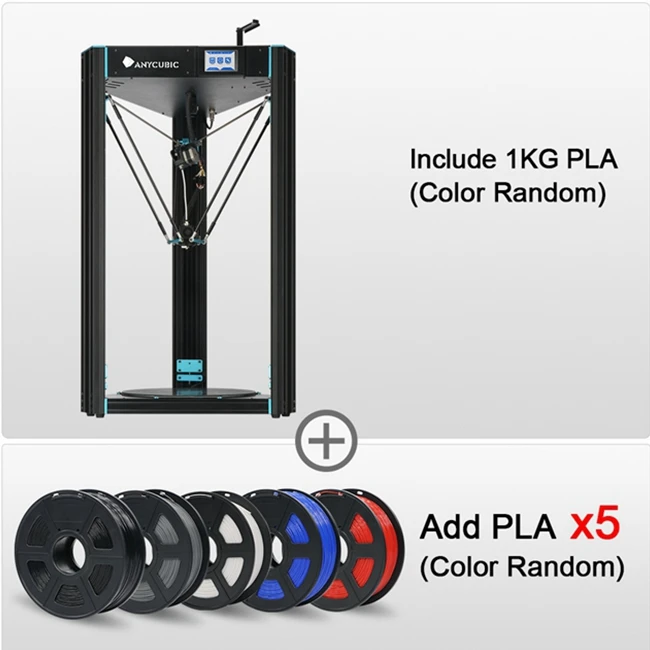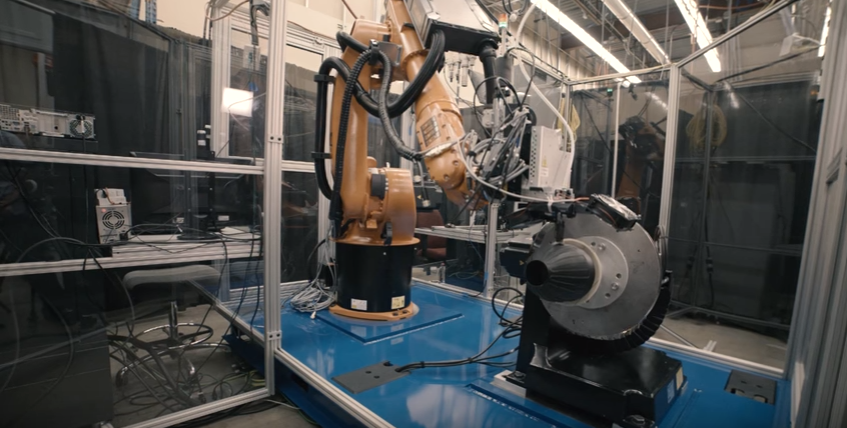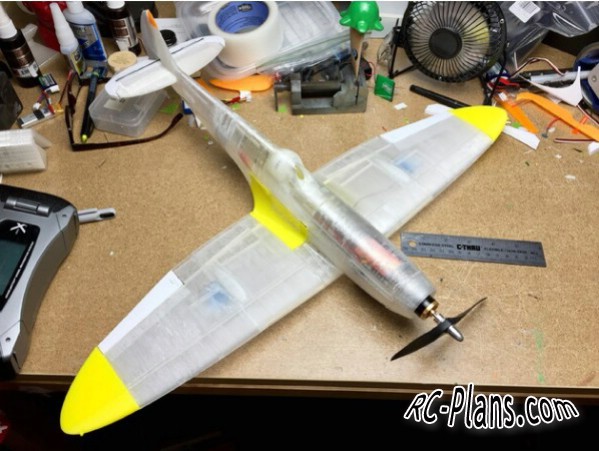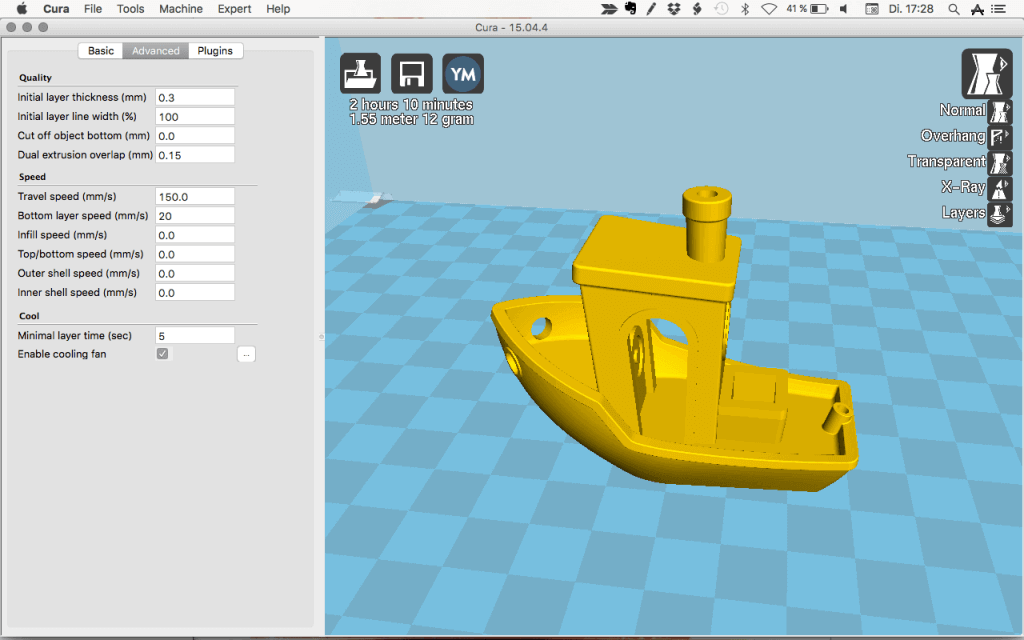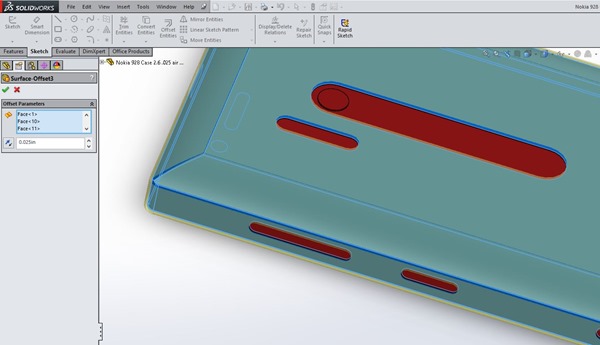Anycubic predator 3d printer
Anycubic Predator 3D Printer - reviews, specs, price
Properties
| Build Volume | 370 x 370 x 455 mm |
| Layer Resolution Low | 300 microns |
| Layer Resolution High | 50 micron (0.002 in.) |
| Nozzle Diameter | 0.4 |
| Filament Diameter | 1.75 |
| Print Speed Min. | 20 mm/s |
| Print Speed Max. | 150 mm/s |
Documents
- Anycubic_Predator(upd_Kossel_user manual).
pdf
Reviews
Anycubic
4.2 2 reviewsPrint Quality
Reliability
Ease Of Use
Failure Rate
Running Expenses
Software
Build Quality
Customer Service
Community
Show reviews Hide reviews
Nov 10, 2022
Easy machine to learn.
Jun 4, 2021
it's a good machine
| Brand | Anycubic |
| Machine type | 3D Printer |
| Technology | FDM (Fused Deposition Modeling) |
| Materials | PLA, ABS, HIPS, Wood PLA, Polycarbonate (PC), Rubber-like (TPU), Ceramic Filament, Wax Filament (MoldLay) |
| Website | https://www.anycubic.com/products/anycubic-predator-fdm-printer |
| Average Price | $459.99 |
Predator is an FDM 3D printer from a Chinese manufacturer Anycubic. The machine has a delta-type frame and provides a great build volume of 370×370×455 mm. The extruder heats up to 250°C. Predator allows to automatically detect 37 points for bed-leveling and supports real-time adjustment to compensate for nozzle height.
The extruder heats up to 250°C. Predator allows to automatically detect 37 points for bed-leveling and supports real-time adjustment to compensate for nozzle height.
Features:
- Extruder temperature up to 250°C;
- Memory card and data cable connectivity;
- Printing speed up to 150 mm/s;
- Automatic bed leveling;
- Solid metal frame;
- Filament outage detector;
- Resume function for power loss;
- Full-color touch screen.
Reviews 4.2
2 reviewsPrint Quality
Reliability
Ease Of Use
Failure Rate
Running Expenses
Software
Build Quality
Customer Service
Community
Show reviews Hide reviews
Nov 10, 2022
Easy machine to learn.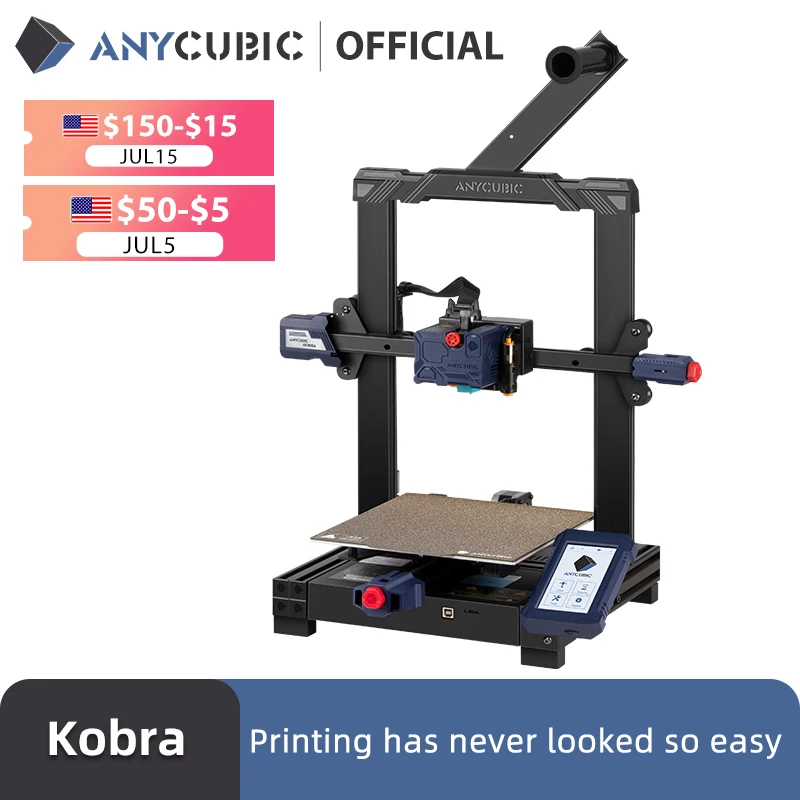
Jun 4, 2021
it's a good machine
Anycubic Predator 3D Printer Review
SCORE: 73
7.3/10
The Anycubic Predator is part of an increasingly rare breed of 3D printers known as delta printers. Typically these printers are well known for their high speed; however, the Predator fails to live up to its speed potential due to a combination of outdated hardware, software and poor quality control. We were disappointed with the Predator as it could represent a good example of a printer in an ever-shrinking market segment. As of right now, there are precious few delta printers available such as the FLSUN Q5, Anycubic Predator and the newly released FLSUN SR. We highly recommend users steer away from delta printers as their speed advantage is negated by poor quality control.
7.3/10
Manufacturer: Anycubic
The Pros
- One of the biggest consumer delta printers that is available
- The Anycubic Ultrabase glass bed provides excellent adhesion when hot and releases prints when cooled
- Uses a full sized SD card instead of a microSD card
The Cons
- Very loud
- Poor print quality due to poor quality control in extruder and arms
- Little community or company support
- Published on July 19, 2022
- 20 min read
Delta 3D printers do not look like your typical 3D printer.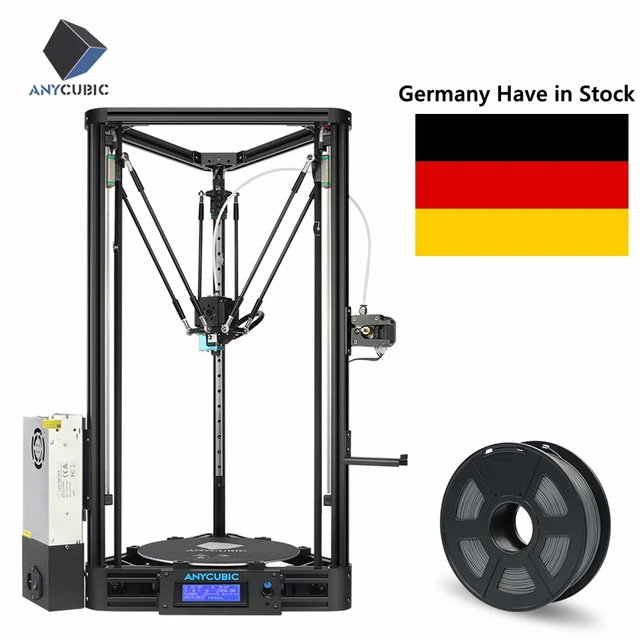 A triangle-shaped tower moving a hotend with 3 arms looks like something out of science fiction instead of your typical plastic production machine. Between 2015-2019, companies such as CNC Me, Anycubic, Tevo and FLSUN made several delta printers for both the low-end and high-end markets. However, modern cartesian and core XY printers have pushed deltas completely out of the market due to their higher print accuracy and affordability, leaving very few deltas printers available on the market today.
A triangle-shaped tower moving a hotend with 3 arms looks like something out of science fiction instead of your typical plastic production machine. Between 2015-2019, companies such as CNC Me, Anycubic, Tevo and FLSUN made several delta printers for both the low-end and high-end markets. However, modern cartesian and core XY printers have pushed deltas completely out of the market due to their higher print accuracy and affordability, leaving very few deltas printers available on the market today.
In 2021, only the FLSUN Q5, Anycubic Predator and the upcoming FLSUN SR remain. At $519, the question is whether delta printers like the Anycubic Predator are still relevant or are they considered a relic of the past? In this Anycubic Predator 3D printer review, we will take a deep look into the Predator’s strengths and weaknesses and see if it has a place in the modern 3D printer market.
Table of Contents
Key Features to look for in a Great 3D Printer
3D printers provide a nearly endless array of possibilities. You should generally know what you plan to print to pick the appropriate printer. However, regardless of what you plan on printing, print quality is always important to focus on. We tested the Anycubic Predator in 4 major areas: the ability to resolve details, z layer alignment, dimensional accuracy, and print repeatability. We scored this printer a 5/10, which isn’t ideal when you check out the other printers we’ve reviewed. We noticed that the predator outputted prints that were average. We saw under and over extrusions on the details. This proves that there are issues with the extruder and previous experience shows that cloned E3D titan extruders generally have poor quality.
You should generally know what you plan to print to pick the appropriate printer. However, regardless of what you plan on printing, print quality is always important to focus on. We tested the Anycubic Predator in 4 major areas: the ability to resolve details, z layer alignment, dimensional accuracy, and print repeatability. We scored this printer a 5/10, which isn’t ideal when you check out the other printers we’ve reviewed. We noticed that the predator outputted prints that were average. We saw under and over extrusions on the details. This proves that there are issues with the extruder and previous experience shows that cloned E3D titan extruders generally have poor quality.
The next thing to look for is print speed & maintenance costs. Depending on how patient you are, some print speeds are tolerable while others are more frustrating. Furthermore, you want to ensure you don’t spend as much on your 3D printer for maintenance as you do on your house. The Anycubic Predator’s stock print speed is 60mm/s, and with its print quality, we, unfortunately, don’t recommend tuning this to go any faster. In terms of maintenance, all components of the Predator can be replaced or upgraded (some silver lining!). Since many of the parts are clones of other products, they are easily replaced with the proper originals.
In terms of maintenance, all components of the Predator can be replaced or upgraded (some silver lining!). Since many of the parts are clones of other products, they are easily replaced with the proper originals.
Lastly, you want to seek community support, so you aren’t going into your 3D printing adventure alone. The Anycubic Predator is not a very popular printer. As a result, there are very few groups that can help answer questions, assist with troubleshooting, and more.
Overall Score
Ranked #33 of 37 Printers
Learn more about our review methodology.
How We Researched This Printer
The Anycubic Predator belongs to the delta family of 3D printers. These printers specialize in very high-speed printing due to their light printhead and quick-moving printer arms. These printers are well known for their circular build volume, breaking speed records and niche community support.
With that in mind, we thoroughly tested the Predator with a large variety of test prints, placed it in several gruelling office environments, crawled through its niche communities to ask questions and more. To get a better idea of its performance, we compared it to other delta printers like the FLSUN Q5 and the FLSUN SR.
To get a better idea of its performance, we compared it to other delta printers like the FLSUN Q5 and the FLSUN SR.
The Predator sets itself apart from other delta printers with its absolutely huge print volume. With its φ370mm x 455mm (h) build volume, it is substantially larger than its closest competitor, the FLSUN SR.
This is a read that you do want to skip out on. Delta printers are a unique breed of 3D printers which combine speed, unique build sizes and movement aesthetics. Due to its unique movement system, choosing the wrong delta printer will lead to major headaches from poor setup, print quality and reliability. Not to mention the time and money wasted trying to fix and tune such a machine. We have sunk the time to research the Anycubic Predator so you can make the right decision on whether a delta printer is right for you.
Printer Setup
Assembling the Printer
The Anycubic Predator ships in 3 major components: the base, top assembly and support pillars. Users will need to bolt the top and base assemblies to the support pillars, connect the arms from the hotend to the support pillar carriages, and connect the cables from the base and hotend to the top assembly. This process is similar to the more recent delta printers, where most of the assembly is done at the factory, allowing users to quickly go from unboxing the machine to printing. In our testing, we took about 45 minutes from unboxing to the first print. The FLSUN Q5, which shares a nearly identical setup process, took about 40 minutes from unboxing to the first print.
Users will need to bolt the top and base assemblies to the support pillars, connect the arms from the hotend to the support pillar carriages, and connect the cables from the base and hotend to the top assembly. This process is similar to the more recent delta printers, where most of the assembly is done at the factory, allowing users to quickly go from unboxing the machine to printing. In our testing, we took about 45 minutes from unboxing to the first print. The FLSUN Q5, which shares a nearly identical setup process, took about 40 minutes from unboxing to the first print.
During our unboxing, we noticed that the Anycubic Predator had a large amount of plastic cling wrapped around the metal support pillars. We imagine this was done to prevent scratches to the finish if parts rubbed against each other during shipping. A minor nitpick was we spent a considerable amount of time unwrapping each extrusion due to the excessive amount of plastic cling wrap.
Leveling the Bed
Anycubic recommends that users use the automatic bed leveling before starting their first prints and it involves attaching the magnetic bed probe to the nozzle and running the bed levelling wizard. It was an easy process which took about 5 minutes, and found that the probe worked very well in making sure the first layer was perfect.
It was an easy process which took about 5 minutes, and found that the probe worked very well in making sure the first layer was perfect.
In our test machine, we found that Anycubic commits these leveling values to memory, allowing users to print constantly without needing to reuse the leveling sensor each time they start a print.
Print Quality
The Anycubic Predator has a large build volume of φ370mm (d) x 455mm (h), which allows it to print a large number of different objects. We greatly appreciate its Ultrabase Pro glass bed and automatic bed levelling, which made printing large objects quite reliable.
We tested the Predator in 4 major areas: the ability to resolve details, z layer alignment, dimensional accuracy and print repeatability. For the tests, we used stock 0.2mm layer height settings in Cura.
To test the Chiron printer’s ability to resolve details, we printed several detailed models, including the standard test model Benchy, a Mandolorian figure and a calibration cube. The Chiron outputted prints that are of average print quality. We have noticed under and over extrusion on the details on the Benchy, Mandalorian and calibration cube. This indicates that there are issues with the extruder, and in our experiences, cloned E3D titan extruders have very poor quality.
The Chiron outputted prints that are of average print quality. We have noticed under and over extrusion on the details on the Benchy, Mandalorian and calibration cube. This indicates that there are issues with the extruder, and in our experiences, cloned E3D titan extruders have very poor quality.
Delta printers require complex calculations to operate effectively. The Predator needs to use trigonometry to move the hotend on the x and y-axis. Cartesian printers, on the other hand, require only simple calculations to move on the x and y-axis. As a result, delta printers require a lot of CPU power to print well. Unfortunately, the Predator is only equipped with a very underpowered 8-bit control board often found in low-end cartesian printers. As a result, flat surfaces on the calibration cube often show blobs and dips as the Predator struggles to accurately and quickly move the hotend to the right location.
We did notice very little ghosting and ringing on prints. A huge advantage of delta printers is their very light-moving hotend and fixed printing surface. This gives delta printers the potential of being the fastest printers and exhibiting the lowest amount of ghosting and ringing out of all 3D printer types.
This gives delta printers the potential of being the fastest printers and exhibiting the lowest amount of ghosting and ringing out of all 3D printer types.
The Anycubic Predator’s joints in its arms also exhibit a lot of play, allowing the hotend to wiggle a few fractions of a millimetre. This play in its arms affects how accurately the Predator can align its layers and affect print quality. In our tests to see how well the Predator can handle z alignment, we printed a very tall 350mm tube. Due to the play in its arms, the Predator will have a few layers shifted a fraction of a millimetre, resulting in what appears to be a very slight bulge.
This play also manifested itself in the dimensional accuracy and print consistency tests when we printed a 20mm calibration cube 20 different times to see if there are any differences between the cubes. We noted that our cube measured 20.5mm (l) x 20.5mm (w), which makes the Anycubic Predator the worst printer we have tested for dimensional accuracy.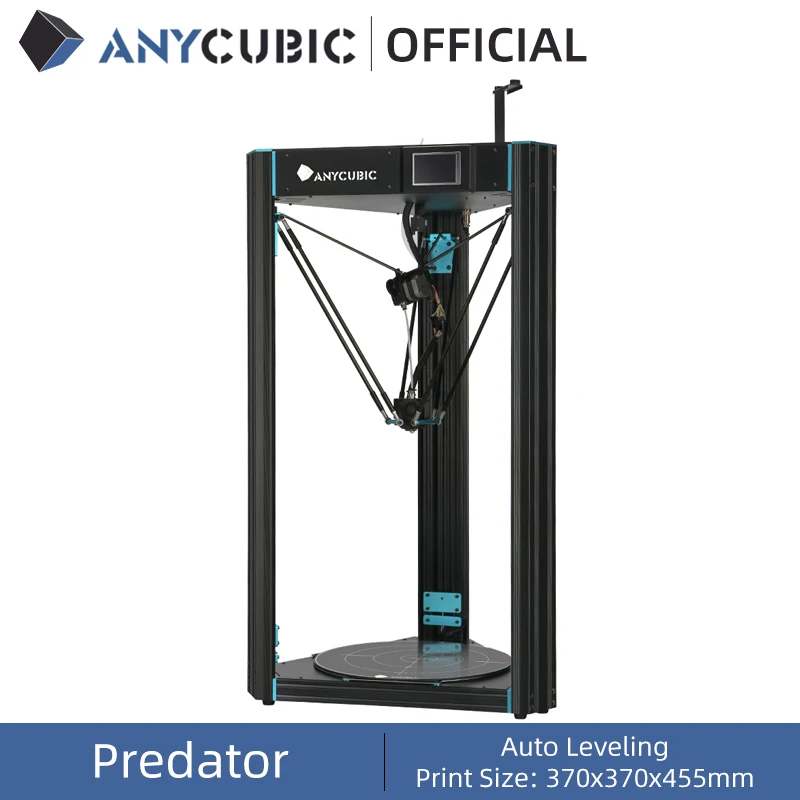 We also noticed that between the first and twentieth calibration cube, there were differences in the finish of the cube due to the inconsistencies introduced by the play in its arms.
We also noticed that between the first and twentieth calibration cube, there were differences in the finish of the cube due to the inconsistencies introduced by the play in its arms.
Print Experience
Overall we were very disappointed with the print experience on the Anycubic Predator. Due to the poor quality control in its extruder and arms, the Predator has very poor dimensional accuracy and average print quality at best.
Print Speeds
Delta printers have the ability to print extremely fast, with many well-built and tuned machines easily achieving print speeds north of 150mm/s. The Anycubic Predator’s stock print speed is 60 mm/s, and with its print quality, we do not recommend printing any faster.
Setting Up Prints
Anycubic ships its printers with Cura 15.0.4.6, which was released back in 2017. Since then, Cura and other slicer programs have made massive leaps in print quality, optimizations and features. We were very disappointed that Anycubic would ship such old software. We proceeded to install this older version of Cura to accurately test the Chiron in its stock configuration. Cura 15 provides a decent but slow user experience, and many advanced users will feel limited due to it lacking many of the modern parameters available to Cura 4.
We proceeded to install this older version of Cura to accurately test the Chiron in its stock configuration. Cura 15 provides a decent but slow user experience, and many advanced users will feel limited due to it lacking many of the modern parameters available to Cura 4.
Users then load their sliced files into an SD card which is inserted at the top of the delta printer. The Predator features a colour touchscreen with easy-to-read menus and icons. Some users might find the text to be a bit small to read, and unfortunately, there is no way to increase font size.
Noise Levels
Unlike other modern printers, the Anycubic Predator is equipped with older A4988 stepper drivers that are extremely loud in comparison to TMC silent stepper drivers, which are featured in many modern printers. This results in Chiron outputting 48db of noise while idle and 60db of noise while in motion. This is the equivalent of a loud office, and we found it very distracting to have the Predator in the same room while it operates.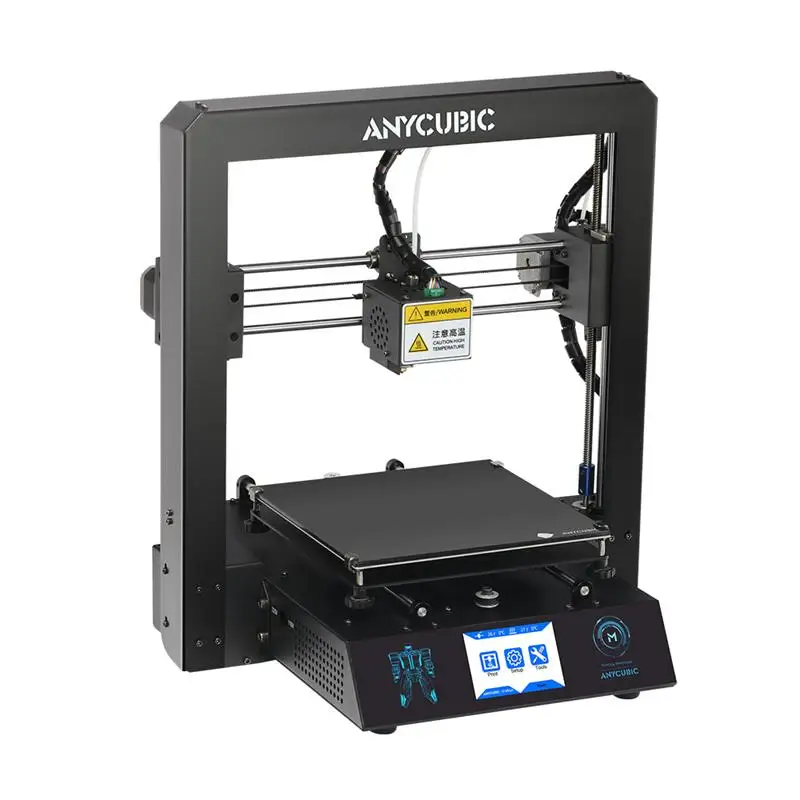
Hardware
The Anycubic Predator occupies a large amount of workspace with overall dimensions of 580mm (l) x 520mm (w) x 1020mm (h) and weighs in at a hefty 19.2kg. Delta printers are unique in that they have a circular build volume instead of a rectangular, and the Predator sports a large φ370mm (d) x 455mm (h) build volume. Compared to other current delta printers, such as the FLSUN Q5 and upcoming SR, the Predator is significantly larger in size and build volume.
Unlike cartesian and core XY machines, delta printers are not space efficient. For example, Anycubic’s Chiron which sports a bigger 400mm (l) x 400mm (w) x 450mm (h) while being slightly wider and substantially shorter at 650mm (l) x 650mm (w) x 720mm (h).
The Predator is constructed with 4080 extrusions and metal sheeting for the base and top of the 3D printer, making it incredibly rigid. Other delta printers, such as the FLSUN Q5, use 10mm steel rods which are far less rigid. This gives the Predator a feeling of sturdiness and durability.
Safety Highlights
One of the biggest concerns of 3D printing is the heater potentially losing control and catching fire. Thermal runaway protection is a software feature that monitors the hotend to ensure it stays within an acceptable temperature range. Most modern printers, including the Anycubic Predator, have it enabled, and we would never recommend a printer without this critical feature. In the case of the Predator, if it detects that the heater’s temperature is going out of an acceptable range, then it will display a heating error message, cut power to the printer and wait for the user to restart the machine.
Cable Relief and Cable Management
We were very pleased with the cable management on the Anycubic Predator. Anycubic has placed a lot of effort into minimizing any exposed cables by having the majority of the electronics store at the top of the delta printer. Power cables to the heated bed are hidden in the thick aluminum extrusion, and cables connecting the hotend to the top of the Predator are wrapped in a flexible nylon sleeve. This results in fewer opportunities for cables to snag and break, making operating the delta printer much safer. Additionally, this helps with the overall aesthetics of the Predator as it has a clean and professional appearance.
This results in fewer opportunities for cables to snag and break, making operating the delta printer much safer. Additionally, this helps with the overall aesthetics of the Predator as it has a clean and professional appearance.
Low Voltage Heated Bed
Common to large format 3D printers is the inclusion of a mains voltage heated bed. This takes power directly from the power outlet to allow for very quick heating of the heated bed. However, this often comes with the risk of electrocuting the heated bed if the power cable breaks. The heated bed of the Anycubic Predator is not mains-powered but instead powered by the power supply of the delta printer. This lower power supply reduces the chance of electrification due to faulty wiring but at the cost of slower heating times. We prefer this style of bed heating as it is much safer for users.
Maintenance
Finding Replacement Parts
Fortunately for Anycubic, all components of the Predator can be replaced or upgraded. The control board, stepper drivers, hotend, extruder and motion components can be replaced when needed, and since many of them are clones of other products, they can be replaced with the proper originals. Due to the popularity of the original products, such as the E3D Titan extruder, they can be found in several 3D printing retailers such as Matterhackers, Spool3d and Digitmakers.
The control board, stepper drivers, hotend, extruder and motion components can be replaced when needed, and since many of them are clones of other products, they can be replaced with the proper originals. Due to the popularity of the original products, such as the E3D Titan extruder, they can be found in several 3D printing retailers such as Matterhackers, Spool3d and Digitmakers.
Accessing the Control Board
Anycubic encloses the electronics of the Predator at the top of the printer. After removing the top cover of the Predator with a few screws, users can fully access all the machine’s electronics. We are very happy with the large number of space users have to access the control board and other components. We were happy to see that Anycubic used the proper connectors and no hot glue to join components together.
Features & Upgrades
Anycubic Ultrabase Pro Glass Bed
The Anycubic Predator is equipped with a branded ceramic-coated glass bed. This glass bed offers two major advantages: the ceramic coating grips PLA, PETG and TPU filaments very well while heated and releases them when cooled. This makes bed adhesion very reliable, with little maintenance required. The second advantage is that the glass is very flat. A flat build surface is critical for prints to adhere properly. Otherwise, prints may fail as parts may detach from uneven build surfaces.
This glass bed offers two major advantages: the ceramic coating grips PLA, PETG and TPU filaments very well while heated and releases them when cooled. This makes bed adhesion very reliable, with little maintenance required. The second advantage is that the glass is very flat. A flat build surface is critical for prints to adhere properly. Otherwise, prints may fail as parts may detach from uneven build surfaces.
Automatic Bed Leveling
The Predator has a unique bed levelling sensor that attaches to the tip of the nozzle. Before the first print, the delta printer will probe several places on the heated bed to accurately gauge the distance between the nozzle and the glass bed to ensure a reliable and accurate first layer. A level bed is critical for print reliability. If the nozzle is too far away from the bed, prints may fail to adhere, and when the nozzle is too close to the bed, the nozzle may jam due to filament being unable to come out.
The Anycubic Predator’s sensor is unique as it is not utilized for every print but used before the first print, and the results are committed to its own board memory.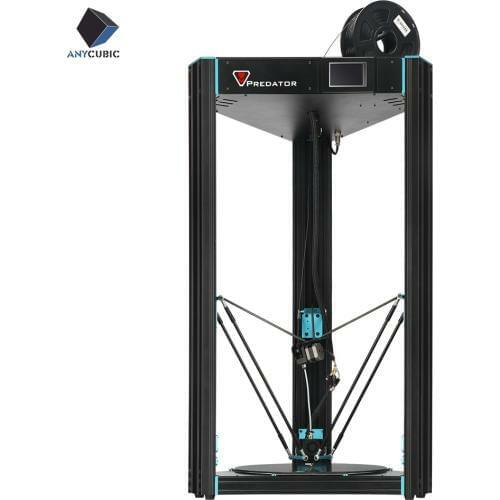
Flying 3:1 Geared Extruder
To print large objects quickly, the Anycubic Predator needs to be equipped with an extruder capable of keeping up with the 3D printer. Anycubic has added a cloned E3D Titan geared extruder that offers far more grip strength than a standard non-geared extruder. This results in potentially faster print speeds and greater print reliability due to the greater filament control.
Traditional delta 3D printers mount their extruders on the side of the printer in a Bowden configuration and require a very long PTFE tube to feed the filament from the extruder to the hotend. This often results in poor print quality due to the long distances the filament must travel before reaching the hotend. Anycubic has mounted the Predator’s extruder in a “flying” configuration where it is suspended above the hotend. This significantly reduces the distance that the filament must travel before reaching the hotend, resulting in much better print quality.
Community Support
Due to the lack of popularity of delta 3D printers in general, the Anycubic Predator is not a very popular printer.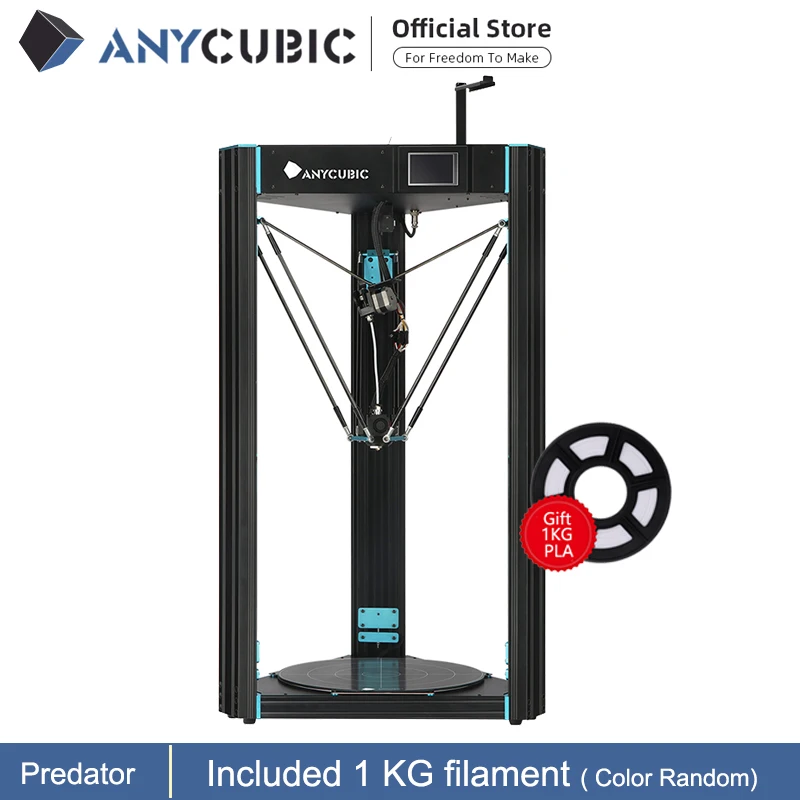 As a result, there are very few groups that Predator users could draw on mods, upgrades and solutions to their issues. A few examples include:
As a result, there are very few groups that Predator users could draw on mods, upgrades and solutions to their issues. A few examples include:
Final Verdict
Overall we really like delta 3D printers. The combination of the fastest print speeds coupled with its science fiction-like movement makes delta 3D printers a head turner among the boxy utilitarian cartesian and corexy printers. Unfortunately, for delta printers to achieve their potential, it requires high-precision components with well-tuned hardware and software. Anycubic has fallen short of that with its underpowered control board and low-quality control in the extruder and arms. As there are currently very few delta printers in the market and none that we recommend, we suggest that users look at printers such as the Creality CR10 MAX if they are looking for a reliable, very large format 3D printer.
Technical Specifications
- Build volume: 370mm x 455mm (h)
- Printer size: 580mm (l) x 520mm (w) x 1020mm (h)
- Weight: 19.
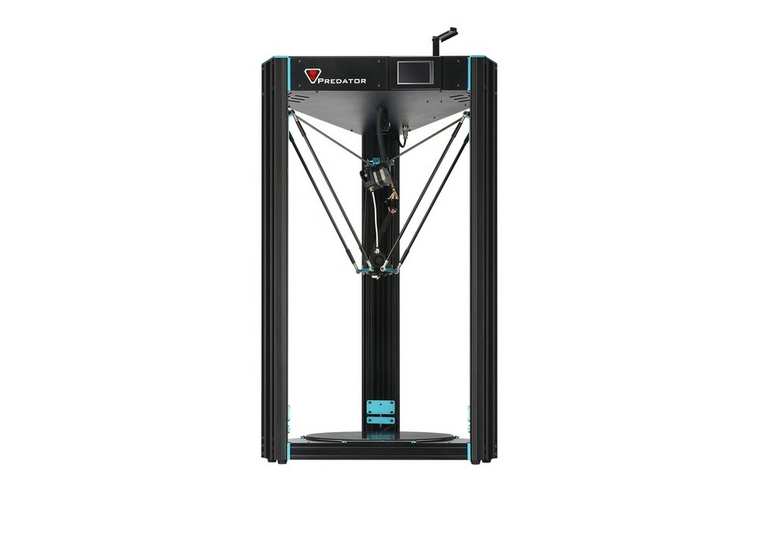 2kg
2kg - Enclosed print area: No
- Display: Colour touchscreen
- Drive type: FDM Direct (ptfe)
- Filament capability: PLA, ABS, PETG, TPU,
- Connectivity: SD card
- Drivers: A4988
- Build Surface: ceramic coated glass
- Heated Bed: Yes
- Bed Leveling: assisted automatic
- Nozzle diameter: 0.4mm
- Maximum hotend temperature: 250 °C
- Maximum movement speed: 150mm per second
- Maximum XY accuracy: 0.1mm
- Minimum Z height: 0.1mm
- Number of extruders: 1
- Filament diameter: 1.75mm
- Supported materials: PLA, ABS, PETG, TPU, 3rd party filament support: yes
- Operating System: Windows, macOS, Linux
- Supported Slicers: Prusaslicer, Slic3r, CURA, Simplify3D
- Supported File Types: STL, OBJ, M3F
Disclaimer
3DGearZone. com is a professional review site that receives compensation from the companies whose products we review. We test each product thoroughly and give high marks to only the very best. We don’t guarantee, however, that our suggestions will work best for each individual or business, so consider your unique needs when choosing products and services. 3DGearZone.com is independently owned and the opinions expressed here are our own. Learn more.
com is a professional review site that receives compensation from the companies whose products we review. We test each product thoroughly and give high marks to only the very best. We don’t guarantee, however, that our suggestions will work best for each individual or business, so consider your unique needs when choosing products and services. 3DGearZone.com is independently owned and the opinions expressed here are our own. Learn more.
Sources
1. Anycubic.com, “Anycubic 3D Printing” Accessed July 26, 2022.
Share Article
Review 3D printer Anycubic Predator
Reviews
Judging by his characteristics, he really is a predator!
Anycubic, a 3D printer manufacturer based in Shenzhen, China, has already made a name for itself in the 3D printing world. Intending to make 3D printing accessible to the masses, the manufacturer has already launched several 3D printers beloved by users, such as the Anycubic i3 Mega S, Photon and Photon S resin printers, Anycubic Chiron or 4Max Pro (Formax).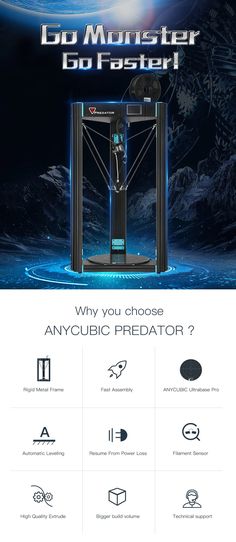 nine0003
nine0003
Now the factory has released the Anycubic Predator (also known as the Anycubic D) and this newest 3D printer in the range could be the biggest one yet. Let's take a look at the spec and find out what makes Predator so special.
1. Large printable area
Generally, Delta printers are somewhat limited in terms of print volume due to the structure of the printer. Of course, you can build a huge delta printer (like the guys at WASP do), but it takes a lot of time for professional engineers to set it up and get decent print results. nine0003
The Anycubic Predator is arguably one of the largest Delta printers on the consumer market. Anikubik's print volume is 370 x 370 x 455 mm , which is slightly less than the maximum height of Tevos Little Monster, which has a height of 500 mm, but exceeds this model in diameter (Tevo prints with a diameter of "only" 340 mm).
2. Ultrabase Pro heated table
Anycubic equips its printer with the already popular Anycubic Ultabase Pro , which provides strong adhesion during printing due to the porous coating layer, while allowing you to easily remove the model after the platform has cooled.
In addition, the table heats up quite quickly, since the voltage has been increased to 24V. According to the Anycubic specification, the table will heat up to 100°C.
3. 37 point auto alignment
Although Ultrabase is available for other third party printers, they do not support auto alignment. For example, Wanhao printers with some types of sensors have problems, they do not 'see' the glass layer on the top of the plate, which makes it necessary to level the table manually. nine0003
But not on Anycubic Predator ! According to the manufacturer's specification, it is calibrated to 37 points and supports real-time nozzle height adjustment.
3. Sensors
The Anycubic Predator is also equipped with sensors. A sensor that will alert you when the filament has run out or broken.
And another useful feature is Resume Printing. It comes in handy when printing is interrupted due to a power outage. You can resume printing, saving hours or even days of reprinting. nine0003
You can resume printing, saving hours or even days of reprinting. nine0003
4. Specifications ANYCUBIC PREDATOR:
MAIN FEATURES
- Print technology: FDM
- Year: 2019
- Manufacturer: Any9 style
Characteristics 3D Press
- Piece region: 370 x 370 x 455 mm
- layer thickness: 0.05 - 0.3 mm
- Type of extruder: Native
- Sopper diameter: 0.4 mm
- Positioning on and and axes: X/ X/ X/ X/ X/ X/ X/ X/ Y/Z 0.0125 mm
- Files: STL, OBJ, DAE, AMF
Dimensions and weight
- Sizes in the collected state: 580 x 520 x 1020 mm
- weight: 19 KG
Subscribe to
not I want
3
3D Anycubic Predator Printer (ID 94025411)
characteristics and description
-
-
Anycubic
-
Buy 3D Printer Anycubic Predator is worth it for anyone looking for a real Predator.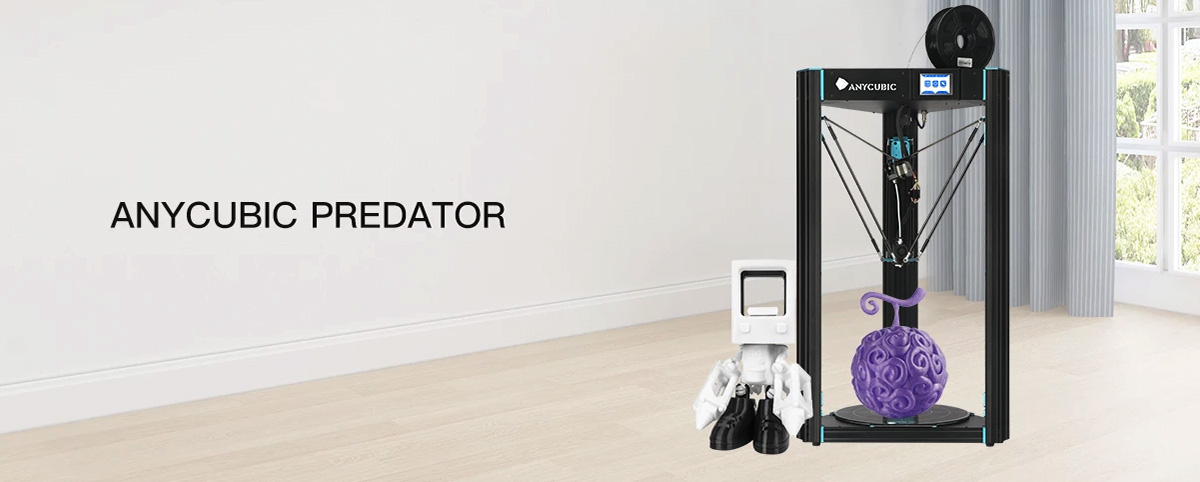 If we talk about the technical equipment of this monster, then it is really on top, and is able to show its teeth to the best flagship models. And most importantly, with the same characteristics, Anikubik's pricing policy will be an order of magnitude lower.
If we talk about the technical equipment of this monster, then it is really on top, and is able to show its teeth to the best flagship models. And most importantly, with the same characteristics, Anikubik's pricing policy will be an order of magnitude lower.
You should start with the print area, which only Tevo Little Monster could bypass, and even then not in all parameters, it is 370 x 370 x 455 mm, although the same Little Monster has a print diameter of only 340 mm. The working surface of the table is made using Ultabase Pro technology, which allows for a strong adhesion of the surface to the first layer of the part to be manufactured. Uniform heating up to 100 degrees makes it possible to work with most types of filament. The table has another important secret - auto-alignment by 37 points, which is not available even to the leading models of 3D printers.
Other things to look out for:
- Plastic thread break or end sensor.
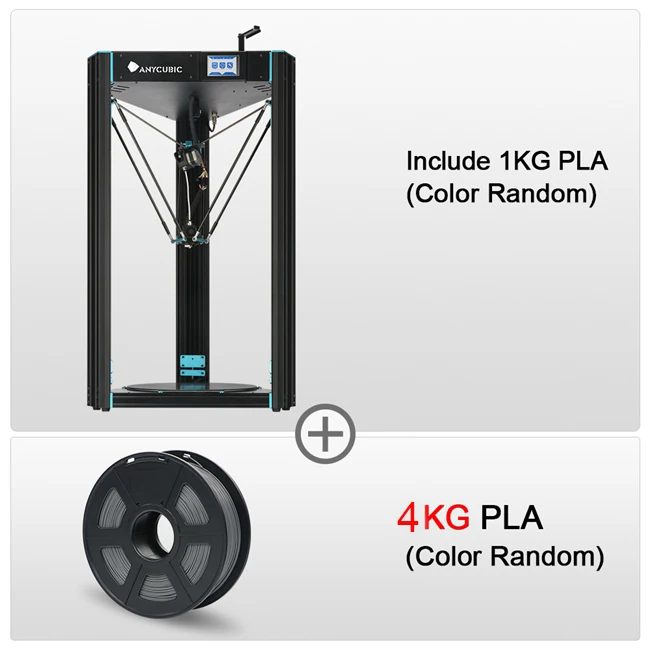 Printing is paused and will be resumed from the same place only after the media is loaded. Also, the sensor is set to cut off the power supply. Unlike many printers, you do not have to start over in this case, there is a magic button to resume printing, which should be pressed after power is supplied. nine0069
Printing is paused and will be resumed from the same place only after the media is loaded. Also, the sensor is set to cut off the power supply. Unlike many printers, you do not have to start over in this case, there is a magic button to resume printing, which should be pressed after power is supplied. nine0069
- Minimum layer thickness is 0.05 mm for excellent accuracy, maximum 3 mm .
- The extruder warms up to 250 degrees, which makes it possible to use the most heat-loving types of filament.
- Calibration no longer needs to be done manually, this printer will do it all by itself when you turn it on.
- Works with different consumables: PLA, ABS, TPU, HIPS, Wood and others.
- A strong all-metal frame ensures rigidity of the structure, and there are no backlashes in the working area.
- Achieves high speed and optimum quality when working with flexible threads.
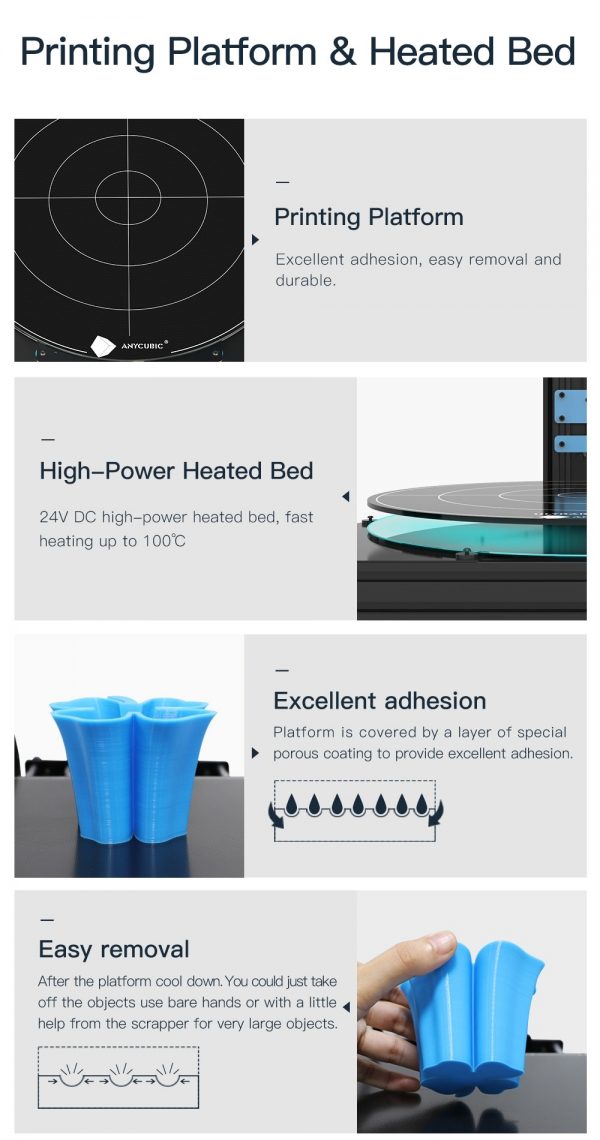 Maximum speed 150 mm/s .
Maximum speed 150 mm/s .
- Intuitive touch screen allows setup in minimum time.
- Lightweight yet durable carbon fiber guides for improved print accuracy. nine0069
- The extruder is cooled by dual fans, ensuring that even poorly cured plastics do not ruin important parts.
In conclusion, ordering the Anycubic Predator 3D printer is a great idea for those who are looking for a powerful, omnivorous Predator capable of providing maximum print accuracy at high speeds. It is especially worth highlighting the budget price segment, which, with such a huge construction area and powerful functionality, does not leave even a shadow of doubt in the choice. nine0069
Was online: Today
Seller Alianza.